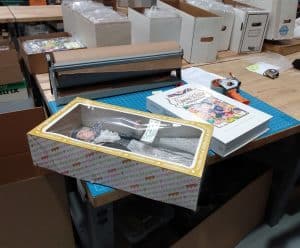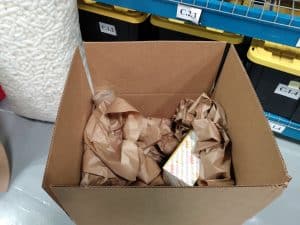Welcome back to Hammer Drops! Every Wednesday, Back to the Past Collectibles shares some of its wisdom accumulated across thirty years selling collectibles. This week, we’re looking at how shipping factors into the world of collectibles selling. If you’re going to sell online, you are going to be shipping stuff out. It’s unavoidable and the price is always increasing. So what are some things to keep in mind?

Dolls from a recent auction prior to being packed.
Size And/Or Weight Are Key
We specify “and/or” because it is easy to forget that they both matter. A foamcore-mounted movie poster may weigh next to nothing but it will still be 27″ x 40″ AND impossible to roll. Likewise, a hundred issues of comic books may not take up much room but it is – as small packages go – pretty heavy.
Everyone expects big and heavy to be costly in shipping, but “big and light” or “small and heavy” are the curveballs that may cause headaches. That’s why we asses shipping on a per item basis, since it can vary quite a bit even within the same broad class of item. Shipping companies charge you for some of the square footage on their trucks, which have a weight limit. The more you take up toward either number, the more they are going to charge you.
Materials And Insurance

Dolls from the same auction mid-packaging. The packing paper obscures about four smaller dolls, all loaded into the equivalent of a medium Uhaul box. Not heavy, but bulky.
An easy way to cut on weight is to cut down on packaging like boxes, void fill, etc. The problem with that approach is that it also cuts down on protection. A prime factor in collectible value is condition, and sturdy boxes with proper void fill for padding is an important part of maintaining it. The more an object can move freely inside a box, the more potential for damage there is. Blunted or bent corners, crunched bubbles, cracked grading cases, et al are the enemies of smooth transactions. Since it’s dang near impossible to stock enough kinds of boxes that fit anything and everything like a glove, good void fill and padding is important. We use a mix of paper, packing peanuts, and bubble wrap as the need may be.
Arriving in the agreed upon condition is the name of the game. Part of ensuring that happens involves a bit more expense. Any item we sell valued at over $100 ships with insurance, no exceptions. Even from just a customer service standpoint, we don’t want to be caught out if a mail truck catches fire or a FedEx van has a piano dropped on it. Insurance against damage helps prevent that from happening. If an item is sold for more than $250, we add signature confirmation. We absolutely do not want our customers falling victim to porch pirates…well, ever really, but especially on high value items.
All of which adds to your shipping costs.It is not unfair to cover the cost of materials in your shipping estimates. It’s part of the cost incurred by shipping items. What is unfair, however, is…
Financing “Good Deals” With High Shipping

Ryan shows off the packing of a high-end Funko Pop: Pop Protector, void fill, and a sturdy box!
We’ve all seen it on eBay: the item listed for five dollars with $30+ shipping. Now, that is sometimes born of necessity – it certainly happens in our auctions from time to time when an item, due to weight and/or size, costs more to ship than it did to purchase. But more commonly, the seller is using their shipping price to make up for a below market item price. To put it mildly, that’s not great practice.
First, it skews the market. Generally speaking, shipping cost is not part of “realized price” and this method of pricing obscures what things are truly selling for. Second, it creates a distrust of shipping costs. While it might pay off in the short term, it just kneecaps the seller, assuming they are trying to build a solid reputation. It’s slimy!
Shipping out items is the most time-intensive part of running an online business. It would be fair to call any collectibles seller with a sizable internet presence a “logistics manager”. By far, the number one thing that people fail to account for when they consider the amount of money to be made selling their collection is the time, effort, and cost of shipping.
Why mess with all that when Back to the Past is here to help bring your collection to market in a way that keeps you from ever thinking about shipping? Give us a call if we can help! On the other hand, If you’re undaunted in your determination to take all the risks to reap all the rewards, Hammer Drops will be back with a new tip next Wednesday!








